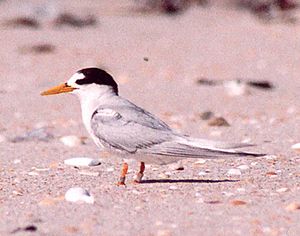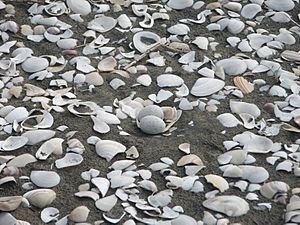New Zealand fairy tern facts for kids
Quick facts for kids New Zealand fairy tern |
|
|---|---|
 |
|
| Conservation status | |
 Nationally Critical (NZ TCS) |
|
| Scientific classification |
|
| Kingdom: | Animalia |
| Phylum: | Chordata |
| Class: | Aves |
| Order: | Charadriiformes |
| Family: | Laridae |
| Genus: | Sternula |
| Species: | |
| Subspecies: |
S. n. davisae
|
| Trinomial name | |
| Sternula nereis davisae Mathews & Iredale, 1913
|
|
The New Zealand fairy tern or tara-iti (Sternula nereis davisae) is a very special bird from New Zealand. It's also called tara-iti in Māori. This tiny bird is a type of fairy tern. It's super rare, with only about 40 birds left! They build their nests in four places along the coast of the North Island, between Whangarei and Auckland. These little birds face many dangers. Things like animals that hunt them, big storms, high tides, and people's activities on the beaches threaten them.
Contents
About This Bird
The New Zealand fairy tern is a special kind of fairy tern. Scientists call it a "subspecies." This means it's a unique group within the fairy tern family. There are two other types of fairy terns. One lives in Australia, and the other lives in New Caledonia.
Scientists first described fairy terns in Australia in 1843. The New Zealand fairy tern was first found in Canterbury by a naturalist named Thomas Potts. He saw them nesting by the Rakaia River.
New Zealand fairy terns look and act a bit differently from the other types. They also have unique genes. This shows that they don't often mix with the Australian fairy terns.
Where They Live
In the late 1800s, people thought New Zealand fairy terns were common. But it's hard to tell them apart from other small terns. So, those old records might not be exact.
From 1940 to 1983, these birds nested in many spots. Their breeding areas stretched from Ruakaka in Northland to Tauranga. They were also seen in Canterbury in the South Island.
However, their numbers dropped very quickly from the mid-1970s. By 1984, they only nested in three places in Northland. These were Papakanui sandspit in Kaipara Harbour, Waipu sandspit, and Mangawhai sandspit.
Today, they still use these three nesting spots. A new spot was added in 2012 at Te Arai Stream. Groups like Forest & Bird are trying to create more safe nesting places. The Department of Conservation and the New Zealand Defence Force even built a nest site at Papakanui in 2018.
What They Eat
New Zealand fairy terns are special in how they find food. Most other terns dive into the deep ocean. But these terns feed in very shallow water. They only go about 5–8 cm deep.
They can catch food in places like estuaries and tidal pools. Adult birds feed their chicks small fish like gobies and flounders. They might also eat many shrimps.
Birds have been seen looking for food in Te Arai Stream. This stream mouth is a popular spot for them after breeding. But it seems they get most of their food from other places.
Breeding and Life Cycle
The fairy terns start looking for partners in September. They lay their eggs between late October and early January. Usually, they lay one or two eggs in each nest.
Their nests are just small hollows in the sand. They don't line them with anything. The Department of Conservation ropes off and watches these nests.
The birds build their nests near white, grey, and orange shells. This helps to hide the eggs and chicks. Nests are usually at least 1 km apart.
Females spend more time sitting on the eggs. Males bring most of the food to the chicks. The chicks can move around right after they hatch. They are ready to fly on their own after about 30 days.
These nests are very delicate. Storms and high tides can easily wash them away. Animals that hunt, like cats or stoats, are also a big danger. People on beaches can also disturb the nests.
When beaches get smaller due to buildings or plants, the terns have to nest closer to the sea. This puts their eggs at higher risk during storms.
Outside of the breeding season, the fairy terns gather in flocks. They often stay around Tapora in the Kaipara Harbour.
Conservation Efforts
By 1983, there were only three breeding pairs and eleven birds left. This was a very low number. So, the New Zealand Wildlife Service started big efforts to save them.
Nesting sites at Mangawhai and Papakanui Spit became protected in 1983. The Waipu site was protected in 1994. These efforts helped the numbers grow.
By 1998, there were 25 to 30 birds, with 8 to 10 breeding pairs. The Department of Conservation's Recovery Plan helped numbers keep rising. By 2006, there were 30 to 40 birds and 12 breeding pairs.
Five years later, the population stayed steady at 40 to 45 birds. There were around 10 breeding pairs. In 2019, there were 45 birds and about 12 breeding pairs.
A plan to help the fairy terns was made in 2005. But the group working on it stopped before the plan ended. In 2008, at least 11 chicks successfully learned to fly. But in the next ten years, no more than 6 chicks flew each season.
The 2018/19 breeding season was very bad. Only five breeding pairs were found, and only 3 chicks hatched. This was the worst season in 27 years. The Department of Conservation thought strong winds might be part of the problem. They also found a "mysterious blue substance" on Waipu beach.
In 2017, it was suggested that a new fairy tern recovery group be formed. This group started in 2019. They are now researching why the birds are declining.
The New Zealand Fairy Tern Trust, started in 2008, also helps. They give up to $40,000 each year to help trap animals that hunt the terns.
| Year | Population estimate | Breeding pairs | Eggs | Fledged chicks |
|---|---|---|---|---|
| 1983 | 11 | 3 | ||
| 1998 | 25-30 | 8-10 | ||
| 2006 | 30-40 | 12 | ||
| 2008 | 11 | |||
| 2011 | 40-45 | 10 | ||
| 2014 | Mangawhai sandspit - 18 | |||
| 2015 | Mangawhai sandspit - 5 | |||
| 2018/19 | 5 | 2 |
Threats to the Fairy Tern
With fewer than 50 birds left, including only ten breeding pairs, the IUCN says this bird is "Critically Endangered." This means it's very close to disappearing forever. The New Zealand government also says it's "probably New Zealand's most endangered native breeding bird."
These birds nest on sand and shell banks just above the high tide line. This makes their nests very open to danger.
- Human activity: People building homes or driving on beaches can destroy nests.
- Introduced animals: Animals like cats, stoats, or even dogs can hunt the eggs and chicks.
- Nature: Big storms and very high tides can wash away nests.
The fairy tern's home is now only in the lower Northland Peninsula.
A golf club was built near a nesting area at Te Arai. There are also plans for new houses next to one of their main breeding spots. This development has caused some disagreement. People are worried about a dam on the Te Arai Stream. This stream is important for the fish that the fairy terns eat.
In 2019, scientists studying fairy terns at Mangawhai thought something else might be harming them. They wondered if removing mangroves from the harbour was linked to the birds' decline. Mangroves are trees that grow in coastal waters.
Images for kids







